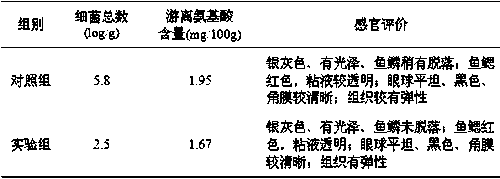Marine low-temperature glucose oxidase and application thereof to preservation of sea product
A technology for glucose oxidase and seafood, applied in the direction of oxidoreductase, meat/fish preservation with chemicals, application, etc., can solve the problems of low glucose oxidase activity and poor fresh-keeping effect, achieve high efficiency of oxygen removal, improve Influence and improve the effect of nutritional value
- Summary
- Abstract
- Description
- Claims
- Application Information
AI Technical Summary
Problems solved by technology
Method used
Image
Examples
Embodiment 1
[0024] The marine low-temperature glucose oxidase of the present invention is an extracellular enzyme derived from Penicillium crustosum , the preparation method is as follows:
[0025] step 1, Penicillium crustosum Inoculated in fermentation medium (10% glucose, 0.5% tryptone, 0.01% NaNO 3 , 0.2% FeSO 4 , 0.2% MgSO 4 , 0.4% KH 2 PO 4 ), 20°C, 160 r / min for 24 h, collect the fermentation broth, detect the enzyme activity as 40 U / mL, filter with Xinhua No. 1 filter paper, and remove the penicillium balls and hyphae;
[0026] Step 2, collect the filtrate in step 1, centrifuge at 8000 r / min for 20 min, remove the spore precipitate, and keep the supernatant;
[0027] Step 3, adding ammonium sulfate to the supernatant obtained in step 2, so that the final concentration of ammonium sulfate reaches 75%, and salting out at 4°C for 12 h;
[0028] Step 4, the fermentation broth after salting out was centrifuged at 12000 r / min for 10 min, and the supernatant was removed to obtai...
Embodiment 2
[0034] The influence of temperature on marine low temperature glucose oxidase of the present invention:
[0035] Step 1, prepare an enzyme solution of 10 U / mL with the pure enzyme solution described in Example 1;
[0036] Step 2, the determination of the optimum reaction temperature, take the enzyme solution and substrate solution at 0°C, 4°C, 10°C, 20°C, 30°C, 35°C, 40°C, 45°C, 50°C, 55°C respectively After bathing in water for 5 min, add the substrate solution to the enzyme solution to react and measure the enzyme activity; the substrate solution is glucose, o-dianisidine, and horseradish peroxidase;
[0037] Step 3, determination of the stability of the enzyme at different temperatures, bathing in water for 60 min at the temperature described in step 2, adding the substrate solution to the enzyme solution for reaction, and measuring the enzyme activity, taking the enzyme activity at the corresponding temperature in step 2 as 100%, and calculating each temperature relative ...
Embodiment 3
[0040] Marine low-temperature glucose oxidase is used in the preservation of prawns, and the preservation methods are as follows:
[0041] Step 1, select fresh prawns and wash them with water;
[0042] Step 2, immerse the clean prawns in the mixed solution of marine low-temperature glucose oxidase and glucose for a period of time; the concentration of marine low-temperature glucose oxidase solution is 20 mg / L, the concentration of glucose solution is 5 mg / L, the concentration of marine low-temperature glucose oxidase solution The mixing ratio with glucose solution is 1:1, and the soaking time of prawns is 4 minutes;
[0043] Step 3, filter off the excess mixture on the prawns on a sieve;
[0044] Step 4, put it in a fresh-keeping box and store it in a refrigerator at 4°C.
PUM
 Login to View More
Login to View More Abstract
Description
Claims
Application Information
 Login to View More
Login to View More - R&D
- Intellectual Property
- Life Sciences
- Materials
- Tech Scout
- Unparalleled Data Quality
- Higher Quality Content
- 60% Fewer Hallucinations
Browse by: Latest US Patents, China's latest patents, Technical Efficacy Thesaurus, Application Domain, Technology Topic, Popular Technical Reports.
© 2025 PatSnap. All rights reserved.Legal|Privacy policy|Modern Slavery Act Transparency Statement|Sitemap|About US| Contact US: help@patsnap.com



